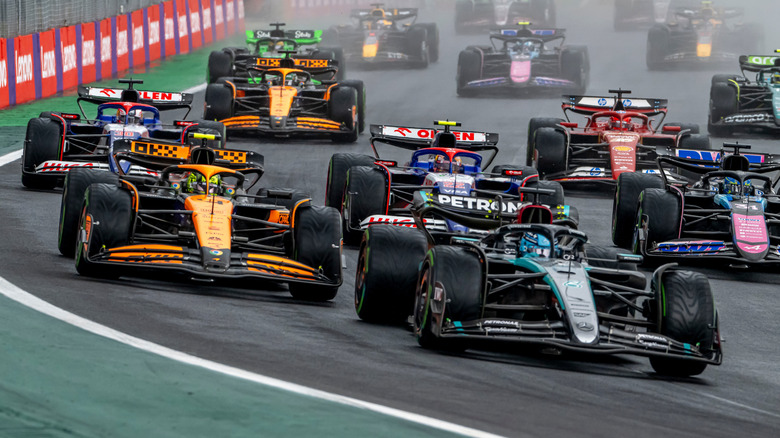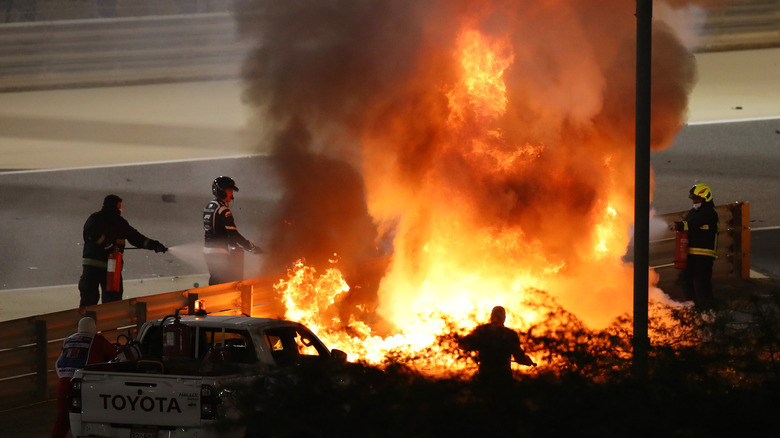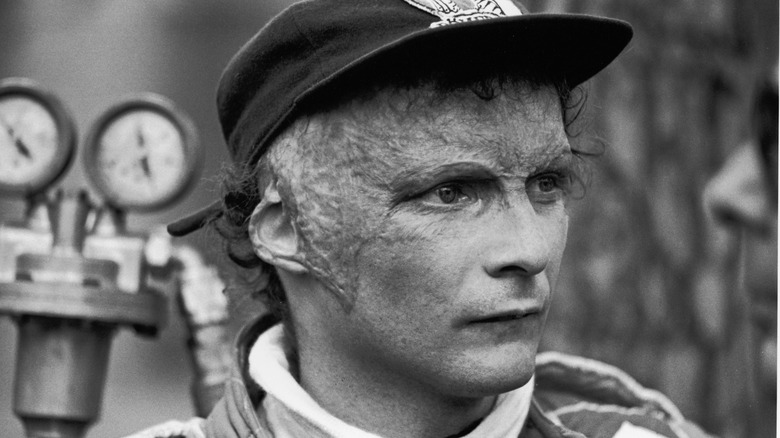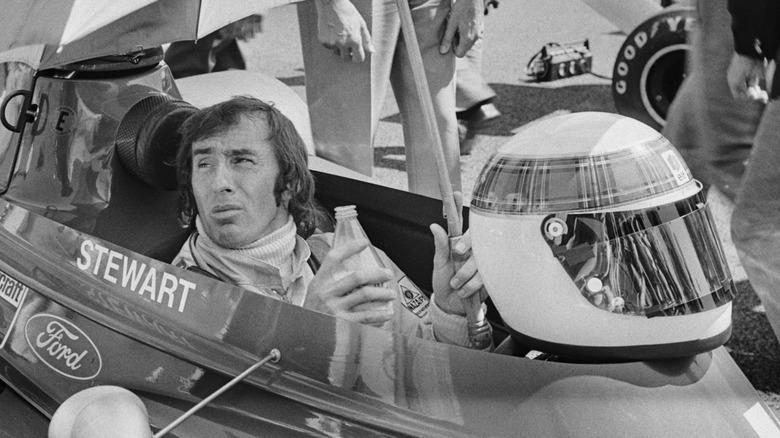5 Of The Worst F1 Crashes Of All Time
Few sports thrill like motorsports. Rivalries and screaming engines, the grandness of victory, and the hollowness of defeat are exciting and dramatic, but the sport's most visceral charge is its fierce danger. Every form of motorsport carries the risk of tragedy, and there is no greater stage than Formula One.
With only 20 seats available, Formula One is the premier series of high-speed circuit racing. Every driver on the grid is a part of a tiny percentage of humans who can pilot a Formula One car. They are all athletes of elite ability, but in motorsport, crashing is inevitable, no matter a driver's skill level. Formula One drivers risk everything for glory and spectacle, and sometimes, that gamble fails.
Romain Grosjean (2020 Bahrain GP)
In recent memory, there is no crash worse than Romain Grosjean's explosive accident at the 2020 Bahrain Grand Prix. In the 15th round of the 2020 season, F1 teams headed to the Bahrain International Circuit to close out the first of the final three races of the season. On the opening lap, Grosjean collided with Daniil Kvyat, causing Grosjean to lose control and crash into the barrier with tremendous force.
The fireball was instant and enormous; the unspoken consensus was that he was dead. But 27 seconds later, Grosjean pulled himself out of the flames, hopped over the metal barrier he had just split open with his car, and was pulled to safety by medics.
The Fédération Internationale de l'Automobile (FIA) launched an investigation into the crash and established that Grosjean crashed at 119 mph and experienced 67 Gs. The spectacle was sobering, with the car splitting in two and the occupied half erupting in flames, but it also demonstrated how far safety measures have come in the tournament. Grosjean faced a worst-case scenario, but thanks to the Halo, flame-retardant racing suits, and other innovations, he was able to step away with only minor burns and a death-defying story.
Niki Lauda (1976 German GP)
The 1976 Formula One season defined one of the sport's greatest rivalries. McLaren driver James Hunt and Ferrari driver Niki Lauda battled all season for the driver's championship (which Hunt ultimately won by one point), and the German Grand Prix was shaping up to be a challenge. The Nürburgring was a notoriously difficult track, and the weekend looked wet. Lauda called for the race to be canceled and had his fellow drivers vote on whether to go through or not. The majority elected to proceed with the race as planned by just one vote.
Then, on just the second lap of the race, Lauda lost control of his Ferrari on the water-glazed surface and spun out into a barrier, bouncing off it into the path of two other cars that struck him. The car was mangled and a fire quickly broke out with Lauda in its center. He was rushed to hospital and received treatment for his severe injuries and burns. A priest even delivered the last rites in his hospital bed. However, six weeks later, he made his triumphant and defiant return in one of the greatest moments in Formula One racing history.
Jackie Stewart (1966 Belgian GP)
Foul weather is a dangerous opponent, and just 10 years before Lauda's crash, racing legend Jackie Stewart had a crash of his own. At this point, safety and preparedness for the worst were not priorities in Formula One. Seatbelts weren't even mandatory for competing cars until 1972, as drivers would rather be thrown out of the car than burnt, as Stirling Moss once said. Jackie Stewart would come to suffer the consequences of this dismissive attitude to safety in the 1966 Belgian Grand Prix at Spa-Francorchamps, another challenging track like the Nürburgring.
On the opening lap, Stewart hit a puddle and hydroplaned at 170 mph into oblivion. There were no crash barriers, and his car ended up crashing through a telegraph pole and a local farmhouse. There was no safety car, and Stewart was initially pulled out of the wreckage by fellow drivers Graham Hill and Bob Bondurant. The crash severed a fuel line, and Stewart was pulled out with broken bones and coated in racing fuel. Eventually, an ambulance arrived and he was taken to the hospital, but only after the driver got lost. Stewart escaped with relatively minor injuries considering the crash's severity, but it highlighted the sport's lack of safety measures. After his crash, Stewart made it his mission in motorsport to make Formula One a safer competition.
Jules Bianchi (2014 Japanese GP)
Although much has changed in the sport since Stewart's crash, racing will always be dangerous. In 2014, a tragic crash at the Suzuka Circuit during the Japanese Grand Prix killed Marussia driver Jules Bianchi. Near the end of the race, heavy rain had caused pooling along the track, and Sauber driver Adrian Sutil hit a puddle and spun off track. A recovery crane was sent out to collect the car. During the recovery process, Jules Bianchi came into that same corner too fast, hydroplaned, and collided with the recovery crane. Bianchi sustained severe head injuries from the crash, which led to a coma and his passing nine months later.
The incident was sobering and a reminder that the sport still had issues, but it also led to one of the greatest modern innovations in motorsport safety. Bianchi's crash highlighted that while much of the driver's body is safe inside the car, the head remained almost completely unprotected, with all faith being put in a driver's helmet. The open cockpit design left the driver's head completely exposed, and it was clear that something had to be done about it. The answer was the Halo, a wraparound frame that maintains visibility while adding a protective shield to the driver's head. This invention would save Romain Grosjean's life in his fiery crash six years later.
Ayrton Senna (1994 San Marino GP)
Ayrton Senna's fatal crash at Imola may be the most infamous in Formula One's history. At the time, the Brazilian driver was on top of the world. He had won 41 Grand Prix races and three drivers' championships in 1988, 1990, and 1991. His yellow and green helmet had become an iconic symbol of what greatness was possible in Formula One.
On the seventh lap of the San Marino Grand Prix, Senna lost control of his car at the Tamburello corner and smashed into the track barrier, obliterating his car and sending the two right-side wheels flying, killing the famous racer. To this day, there is still speculation about what caused the crash. Some attributed it to driver error, as the Tamburello corner is one of the more difficult turns at Imola, and typically taken flat out. Others blamed a faulty steering column that prevented Senna from wresting control. Senna's death was a tragedy that changed Formula One forever, but his legacy lives on, and he is recognized as one of the greatest Formula One drivers of all time.





